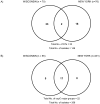Multilocus sequence typing of Borrelia burgdorferi suggests existence of lineages with differential pathogenic properties in humans
- PMID: 24069170
- PMCID: PMC3775742
- DOI: 10.1371/journal.pone.0073066
Multilocus sequence typing of Borrelia burgdorferi suggests existence of lineages with differential pathogenic properties in humans
Abstract
The clinical manifestations of Lyme disease, caused by Borrelia burgdorferi, vary considerably in different patients, possibly due to infection by strains with varying pathogenicity. Both rRNA intergenic spacer and ospC typing methods have proven to be useful tools for categorizing B. burgdorferi strains that vary in their tendency to disseminate in humans. Neither method, however, is suitable for inferring intraspecific relationships among strains that are important for understanding the evolution of pathogenicity and the geographic spread of disease. In this study, multilocus sequence typing (MLST) was employed to investigate the population structure of B. burgdorferi recovered from human Lyme disease patients. A total of 146 clinical isolates from patients in New York and Wisconsin were divided into 53 sequence types (STs). A goeBURST analysis, that also included previously published STs from the northeastern and upper Midwestern US and adjoining areas of Canada, identified 11 major and 3 minor clonal complexes, as well as 14 singletons. The data revealed that patients from New York and Wisconsin were infected with two distinct, but genetically and phylogenetically closely related, populations of B. burgdorferi. Importantly, the data suggest the existence of B. burgdorferi lineages with differential capabilities for dissemination in humans. Interestingly, the data also indicate that MLST is better able to predict the outcome of localized or disseminated infection than is ospC typing.
Conflict of interest statement
Figures



References
-
- Dennis DE, Hayes EB (2002) In: Gary SJ, Kahl O, Lane RS, Stanek G, editors. Lyme borreliosis: Biology, Epidemiology and Control. CABI publishing, Oxford, UK. 251–280.
-
- Center of Disease Control and Prevention (2012) Lyme Disease - United States, Available: http://www.cdc.gov/lyme/stats/index.html.Accessed 14 March 2013.
-
- Wormser GP, Dattwyler RJ, Shapiro ED, Halperin JJ, Steere AC, et al. (2006) The clinical assessment, treatment, and prevention of Lyme disease, human granulocytic anaplasmosis, and babesiosis: clinical practice guidelines by the Infectious Diseases Society of America. Clin Infect Dis 43: 1089–1134. - PubMed
-
- Wormser GP (2006) Hematogenous dissemination in early Lyme disease. Wien Klin Wochenschr 118: 634–637. - PubMed
-
- Attie O, Bruno JF, Xu Y, Qiu D, Luft BJ, et al. (2007) Co-evolution of the outer surface protein C gene (ospC) and intraspecific lineages of Borrelia burgdorferi sensu stricto in the northeastern United States. Infect Genet Evol 7: 1–12. - PubMed
Publication types
MeSH terms
Grants and funding
LinkOut - more resources
Full Text Sources
Other Literature Sources

